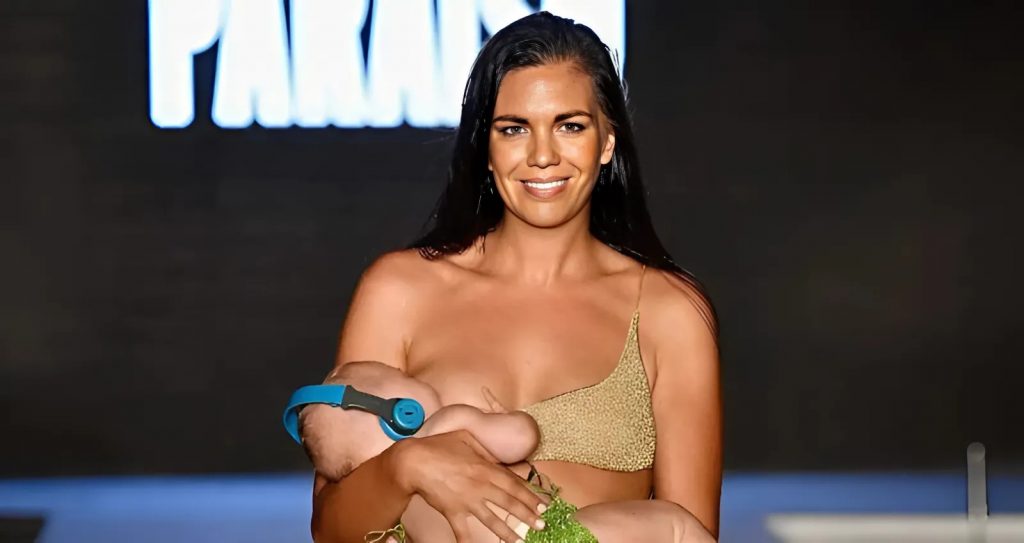This model breastfeeds her child during a runway show: «I insist that my baby be breastfed in public.»She’s breaking norms and nursing on stage!

In a world where fashion and performance frequently collide, the boundaries of expression are constantly being redefined. One such moment—simultaneously tender and revolutionary—occurred when American model Mara Martin took to the runway at a Miami Swim Week show, not only wearing designer swimwear but also cradling and breastfeeding her infant daughter. The image was powerful. It was intimate. And most of all, it was unapologetic.
For Martin, this was not merely a spontaneous gesture of maternal necessity. It was a statement. «I want my baby to be breastfed in public,» she later said, echoing the sentiment of countless mothers who face stigma and social discomfort for doing what is, by all biological and ethical standards, natural. Yet, the reactions to this moment reveal something much deeper—how society continues to struggle with reconciling the female body’s function with its objectification.
The Normalization of the Taboo
Despite the rise of progressive values and the amplification of body positivity movements, breastfeeding in public continues to generate discomfort in many circles. It raises eyebrows in restaurants, draws stares on park benches, and sparks debates in legislative chambers. For something that has been practiced since the dawn of humanity, breastfeeding remains strangely taboo. The contradiction is striking: women’s bodies are celebrated and sexualized across billboards, music videos, films, and advertisements, yet the sight of a woman feeding her child often provokes offense.
Martin’s walk down the runway shattered this double standard in a venue not typically associated with maternal imagery. Fashion shows are about image, presentation, allure. They are meticulously curated expressions of beauty and power. And yet, Martin introduced a dimension seldom acknowledged in such spaces: motherhood.
A Cultural Crossroads
The reactions were swift and polarized. Admirers hailed the act as empowering, a bold challenge to outdated norms. Critics, however, questioned its appropriateness and accused Martin of turning motherhood into a performance.
But isn’t that the point?
For too long, the conversation around public breastfeeding has been controlled by those who are made uncomfortable by it. Martin’s performance reclaimed that space, showing that breastfeeding does not need to be hidden, minimized, or justified. It does not require permission. By breastfeeding on the runway—a place where bodies are usually objectified and commodified—she reclaimed the narrative around the female body and repurposed it as a tool of nourishment, strength, and agency.

The irony is palpable. Society often praises women for “bouncing back” after childbirth, as if their primary goal should be to erase the evidence of motherhood from their bodies. But when a woman embraces the full spectrum of her identity—including the role of nurturer—she is seen as stepping out of line. Martin’s runway walk pushed back against this toxic dichotomy.
Beyond the Headlines
It is easy to reduce the moment to a viral stunt. But such a reduction fails to appreciate the depth of what Martin represented. She is not the first woman to breastfeed in public, and she certainly will not be the last. Yet by doing so in one of the most visual and scrutinized platforms available—a fashion show—she brought the issue to the forefront in a way that could not be ignored.
This was not an isolated act of defiance. It was part of a broader movement. Around the world, women are advocating for breastfeeding rights in public spaces, in workplaces, and in institutions. Legal protections vary widely by country and region. In some places, breastfeeding in public is still met with legal consequences or social ostracization.
And yet, the act itself is a basic human right. It is essential for infant health. It is recommended by virtually every medical authority on earth. And it is an expression of the bond between mother and child that should be celebrated rather than censored.
The Visual Power of Vulnerability
What makes Martin’s moment so memorable is that it was not carefully filtered or airbrushed. It was raw. Vulnerable. Real. In an industry often criticized for its artificiality, this display of authenticity stood out precisely because it wasn’t trying to conform. The sight of a woman doing something so instinctual in an environment built on spectacle reminded viewers that beauty does not need to be sterile or detached from reality.
The runway has long been a place of transformation—where art, fashion, and politics often intersect. Designers have used it to make statements on climate change, war, gender identity, and racial justice. Why should motherhood be any different?
A Step Forward
Ultimately, Mara Martin’s choice to breastfeed on the runway wasn’t about courting controversy. It was about normalizing a fundamental aspect of life that has been marginalized for too long.
RELATED NEWS...
 Top Video Viral
Top Video Viral

